What Kind Of Animals Live In Canals
With more 100,000 plant and fauna species, rivers grow with wildlife. Even fish living in these freshwater habitats include hundreds of species.
The Mississippi River in the U.s.a. alone boasts more one hundred species of fish.
That being said, fish are far from being the only animals living in rivers. Animals ranging from mammals to amphibians to reptiles to birds besides phone call rivers home.
Below are xv different types of animals that live in rivers. While some of these animals are widely known to inhabit rivers, others aren't and may just surprise you lot!
ane. American Alligators

One time an animal on the verge of extinction, the American alligator, thanks to state and federal laws and concerted efforts to preserve natural habitats, at present thrives in the southeastern portion of the United states of america, primarily in Louisiana and Florida.
When one looks at an American alligator's armored, scale-covered body, impressive musculature, and clenching jaws, information technology should come as no surprise that they're distantly related to the clade Dinosauria reptiles (popularly known as dinosaurs).
Although alligators are known to inhabit rivers, they can also exist found in lakes, swamps, and marshes. Out of the h2o, they can exist quite heavy and impuissant.
After all, they range from 9 to 15 feet in length and tin can counterbalance around 1,000 pounds.
Under the h2o, they're practiced swimmers, preying on fish, small-scale mammals, and snakes. However, when hungry, an American alligator might exist found preying on almost annihilation, including carcasses, domestic pets, and even humans.
When born, they're known as hatchlings. These infants can be anywhere from 6 to eight inches in length.
Due to their small-scale size and vulnerable nature, juveniles are enticing prey for raccoons, bobcats, and birds, as well as other alligators, then they typically stay with their mothers for protection and survival for around two years.
2. Blue Crabs
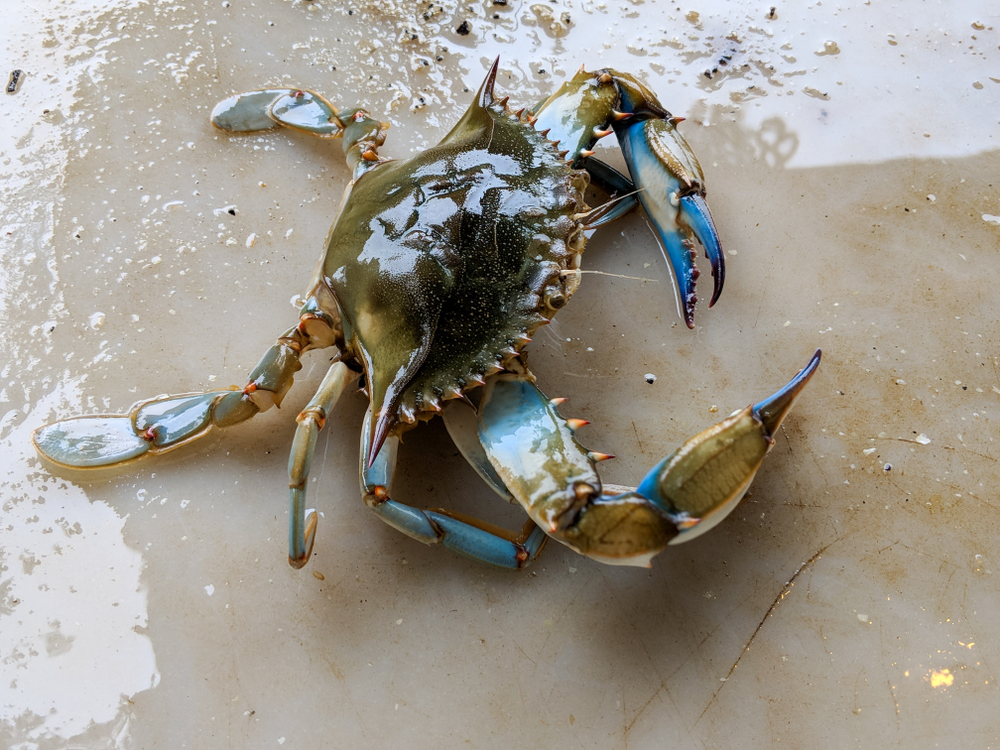
Named due to its blue-colored claws, the blue crab is armed with a brownish shell, also referred to as a carapace. Dissimilar the males, the females have red-tipped pincers.
Blue crabs are among the nearly harvested animals on earth, coveted by humans worldwide for their sweet and tender meat. Even their scientific name (callinectes sapidus), which means "savory beautiful swimmer," is a testament to this fact.
These freshwater omnivores can be found from the lagoons of Nova Scotia to the Gulf of Mexico. They take even been seen as far south as Uruguay.
Closely related to the lobster and shrimp, the bluish crab uses its prickly covering and pointer pincers to ward off predators.
Blue crabs aren't picky eaters and feed on almost anything. Food for these creatures may include fish, plants, mussels, carcasses, and fifty-fifty other blue venereal.
Males tin be as wide as 9 inches. With their paddle-shaped hind appendages, blue crabs make well-adjusted swimmers.
They're highly sensitive to changes in their habitats and the surround. Several of their populations, especially in the Chesapeake Bay in the eastern part of the United states of america, take seen a dramatic decline in population.
This is bad news not just for blue crabs simply too for the ecosystems they live in because bluish venereal play an important role in decision-making the populations of the species they frequently prey on.
Because of the detrimental furnishings of overharvesting, regulations accept been put in place to ensure that blue crabs remain a thriving species.
iii. Amazon River Dolphins
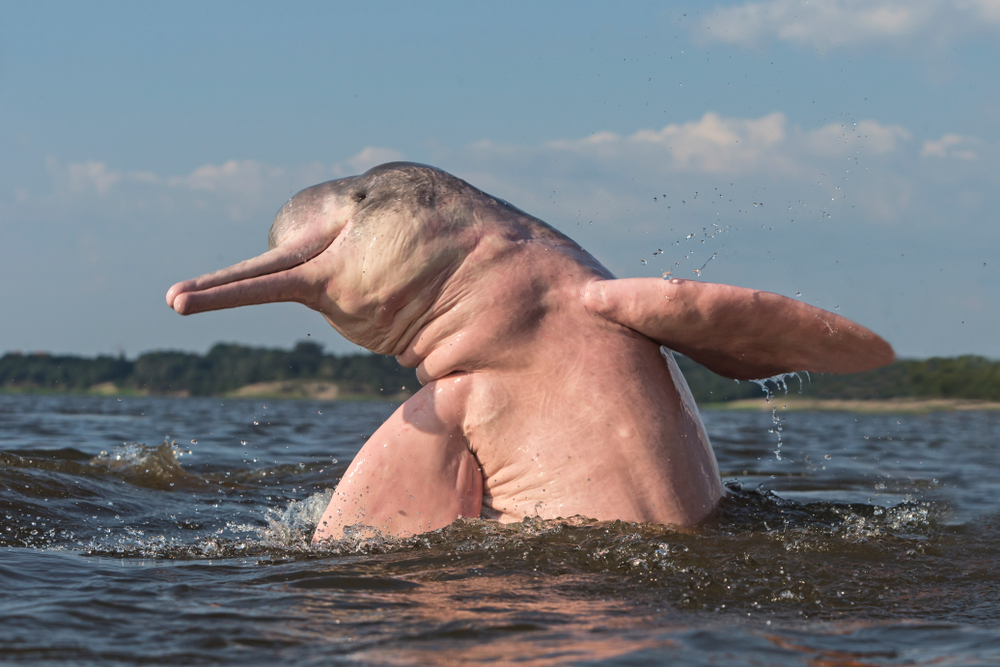
Each jump, during heavy rainfall the famous Amazon River, along with its tributaries, begins to expand. Over the form of time, the Amazon Rainforest becomes flooded, resulting in a vast, freshwater sea.
The Amazon river dolphin, likewise known every bit the boto, swims into this seasonal sea, which lasts for about half a year.
Simply like their cousins inhabiting the bounding main, botos wear the well-known dolphin smile, but, unlike their oceanic dolphin counterparts, they accept characteristically long, skinny beaks and round, bulging noses.
Males can have a pinkish color, which is about likely scar tissue resulting from crude play or fighting over mates. The pinker their colour, the more appealing the males are to the females.
This is especially true during mating season, which happens when the water has retreated, and the dolphins are once again limited to the river aqueduct.
To impress females, males sometimes agree their prey, such every bit turtles, up in the air or beat against the water with branches in their mouths.
Pregnancy lasts betwixt 11 and 15 months for female person botos. Young botos nurse for over a year, keeping shut to their mothers for protection.
Botos, due to their flexible vertebrae, have the power to easily maneuver between trees and through branches.
Their long snout also allows them to dig through river mud for casualty, such as crustaceans, or swim through branches in search of fish.
They also benefit from echolocation, which helps them navigate through the dark h2o and locate their prey. The largest among the 4 species of dolphin, botos tin grow as long equally viii anxiety and counterbalance equally much as 450 pounds.
The only danger to Amazon river dolphins is humans, who harvest them for catfish bait or trap them past accident in gill nets.
There's a traditional belief in the Amazon that the boto is a magical brute. The belief holds that boto can come aground in human form wearing a chapeau to hide its blowhole.
four. American Eels

The American eel is a catadromous species, which means it lives in freshwater during its adult life earlier migrating to the ocean to spawn. Once information technology has spawned, the eel dies.
Humans are among the biggest threats to the American eel and harvest this brute for both allurement and nutrient.
Nigh of the harvesting takes place along the Atlantic Coast, where the eels are known to thrive, and then the eels are exported abroad.
Eel is rarely eaten in the United states, but many countries in Asia and Europe care for the eel every bit a celebrated delicacy.
Due to overharvesting, the US and Canada take gear up regulations to manage the hunting of eels and restore their populations.
The American eel tin exist as long as 20 inches and weigh every bit much every bit xvi pounds.
Their young start as eggs in the Sargasso Sea and hatch after about 2 to iii weeks. The sea currents carry the immature until they get to the coastline. Afterward, they swim upstream.
Throughout this whole process, the eel undergoes a series of transformations, and it takes them betwixt five and 25 years to reach sexual maturity.
Developed American eels normally eat at nighttime, feasting on small fish, worms, crustaceans, and mollusks.
five. Diving Bell Spiders

The diving bell spider, ordinarily known as the water spider, is different from nigh of its arachnid cousins considering it spends the majority of its time underwater.
What makes this brute even more interesting is the fact that it can stay underwater for such long periods of time even though its trunk is like that of a normal terrestrial spider.
Interestingly, these spiders are so adept at being underwater that they only seldomly have to rising to the water's surface for air.
Male water spiders (7.8 to 18.seven mm) are, on average, larger than females (seven.eight to 13.1 mm). The larger the male'due south body size, the better its mobility and, therefore, the better its chances of finding mates and prey.
On country, the water spider appears to have a nighttime velvet-colored belly, as well as a brown cephalothorax. However, underwater, they look more silvery in advent, and this is largely due to the air chimera surrounding their abdomen.
The hair on the spider'south abdomen allows it to capture air bubbles.
To create a "diving bell," as the air chimera is oftentimes referred to, the spider rises to the surface, captures a chimera of air, hauls the bubble underwater, and releases it under a awning-like cover.
This "canopy" is made of a silk sail attached between stems of water plants.
It's inside this diving bell that the spider spends the majority of its time. The spider does almost everything in this sac, from eating to resting to reproducing, only coming up to the surface of the water to gulp air.
The males' longer chelicera, longer front end legs, and longer bodies give them an advantage over females when it comes to diving underwater.
Although the water spider's seize with teeth is known for being painful to humans, it's non believed to be particularly unsafe. The worst possible effects of the spider'southward bite are fever or inflammation.
The water spider prefers to prey on crustaceans as well every bit aquatic insects.
six. Red-Eared Slider Turtles
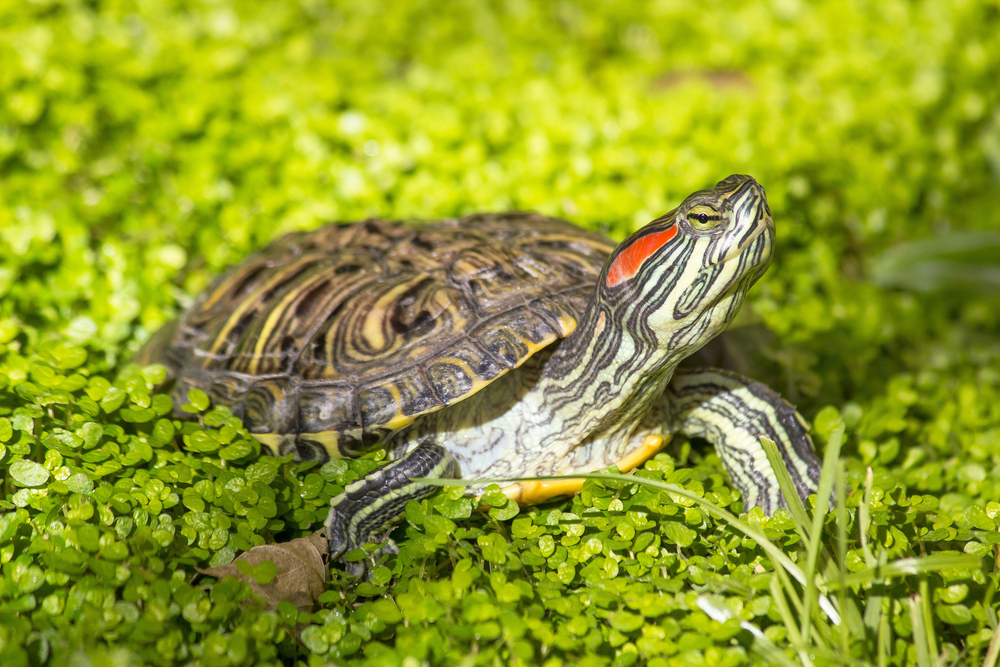
A pop household pet, the red-eared slider turtle is an fauna that starts off very small but grows to a very large size over a long catamenia of time.
Therefore, they need to live in large habitats and areas in which they can freely and hands move around.
Although young sliders have a bright dark-green shell, the colour dulls as they get older. Instead of teeth, sliders have a beak fabricated of keratin protein lying on top of their jawbones so they can rip autonomously and tear their food.
The carapace is the peak portion of the beat out, and the lesser part is the plastron. Both the carapace and the plastron are covered in scutes, which are bony plates with a keratin protein covering.
Sliders are social creatures that bask each other's company. They're also skilful swimmers that spend the majority of their fourth dimension underwater.
Male sliders tin can exist distinguished from females by their smaller size, longer nails and tails, and curved plastrons, which assist them during mating.
These turtles are omnivorous creatures with a palette for a broad diverseness of foods, including fruits, fishes, amphibians, and underwater vegetation and invertebrates.
7. Belted Crayfish
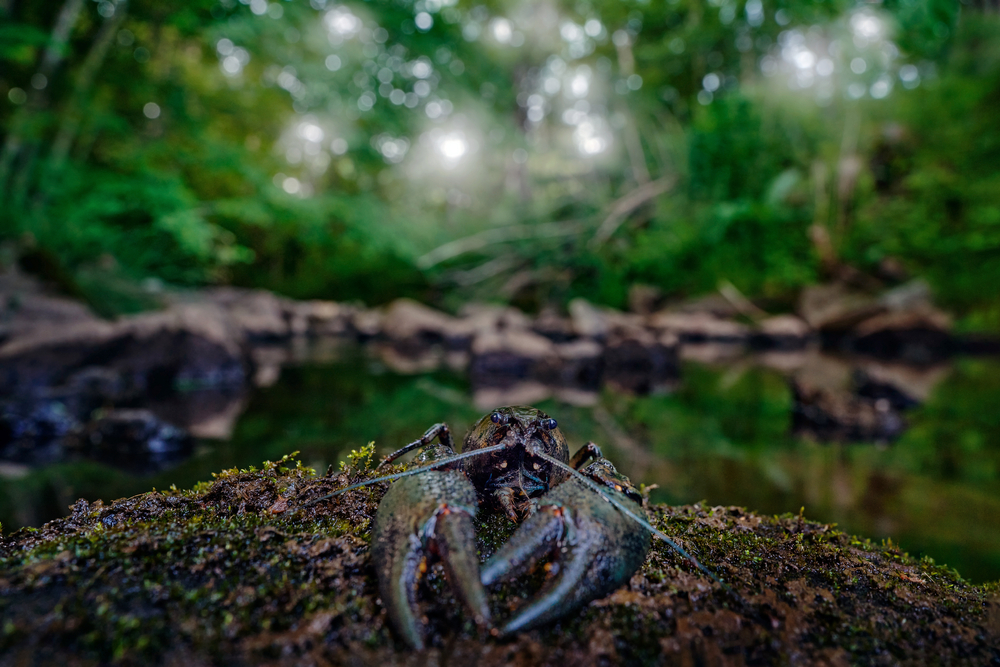
Physical features of the belted crayfish include its medium-small size and tan colour overlaid by green and red bands on the animal'south abdomen.
There'due south too a blackish ring on the carapace, spanning the cervical groove (which separates the caput and thorax). Some other blackish ring can exist seen where the carapace and belly are joined together.
The crawfish's pincers are narrow compared to those of other stream crawfish, merely they aren't exceptionally long.
Living in streams ranging from creeks to rivers, the belted crayfish prefers soft currents and coarse rock. During the daytime, this creature hides underneath rocks, and at night, it forages for food.
It cannot traverse country and, thus, is limited to sure river systems.
Although crayfish are known to inhabit the Meramec River and Big River drainages in Missouri, they were recently introduced into the drainages of the St. Francis River.
They've get particularly invasive in the St. Francis River drainages, where they've been feeding on and displacing organisms within that aquatic system.
A generally omnivorous fauna, the belted crayfish enjoys feeding on many types of plants and animals.
At the same time, it's a huge source of meat for humans, equally well every bit many animals that alive in or around water, including snakes, fish, turtles, raccoons, birds, and mink.
8. River Otters
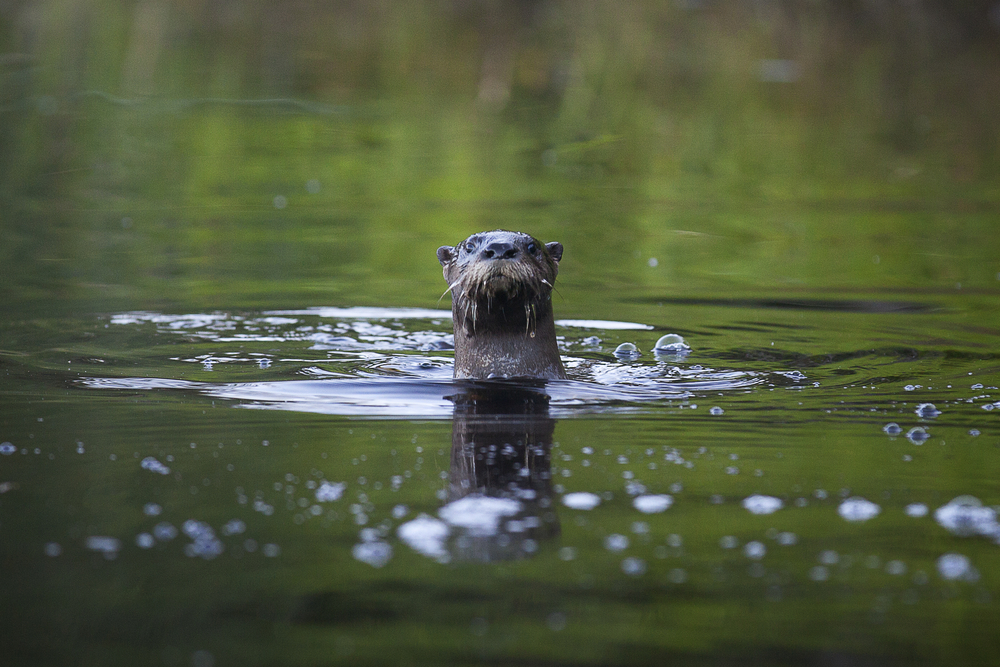
Although river otters by and large inhabit areas around rivers, they're also known to alive most lakes and streams.
Playful animals that savor sliding down muddied hills during the summer and wrestling on snow and ice during the wintertime, river otters tend to live virtually water that'southward bordered by woods and wetlands (east.g., marshes).
With their long, slender bodies, webbed hind feet, and strong tails, they're excellent swimmers that can stay underwater for as long as four minutes.
While underwater, they go on their ears and eyes shut to prevent water from entering.
As aquatic creatures, they ofttimes hunt underwater, preying on fish, their primary nutrient. Once they take hold of their casualty, they drag them onto shore to feast on their bounty.
River otters spend a large portion of their fourth dimension underwater, only they do savor traveling across state as well, oft looking for a mate.
When they travel across the land, they tin be observed running a few steps before sliding on their bellies.
nine. Brazos Water Snakes
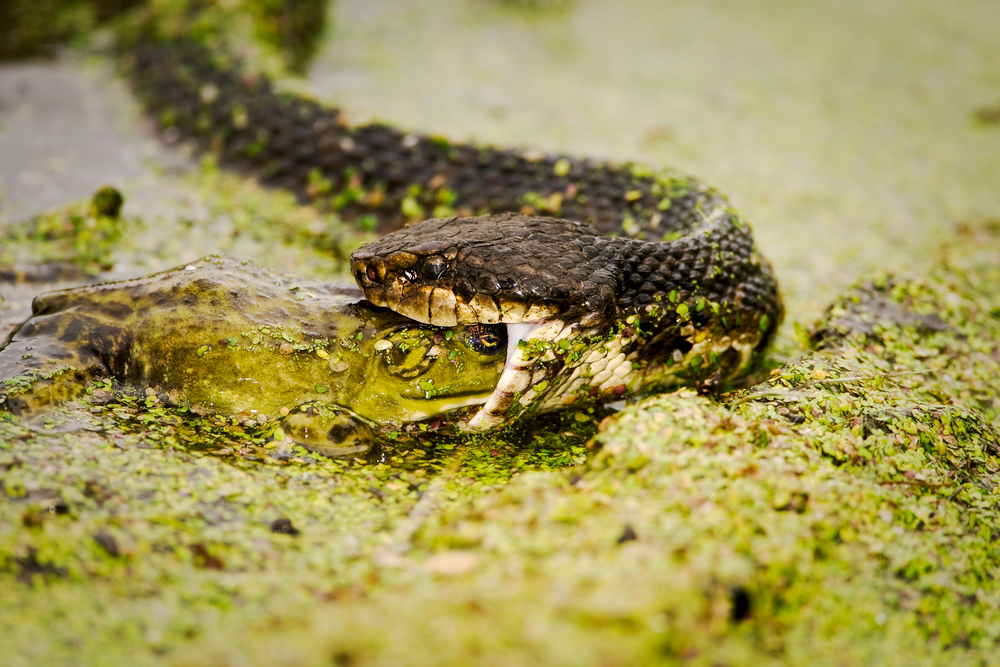
Almost exclusively confined to the northern parts of the Brazos River drainage, the brazos h2o snake is recognized by the Texas Parks and Wild animals Section equally a threatened species.
Information technology's also nether the protection of the Texas Parks and Wild animals Lawmaking.
This serpent can be identified by its dark-brown/gray or dark-brown/green combination. It also has a checkerboard advent, which, along with its pink or orange abdomen and yellow or cream-colored neck, brand information technology hard to miss out in the wild.
The brazos water ophidian prefers living in water that has fast currents, rocky floors, and lots of vegetation. The serpent tends to hide under rocks or among vegetation when it senses danger, and information technology also likes to inhabit rocky riffles.
It typically feeds on small fish, just information technology's besides been known to prey on a diverseness of animals, such as crayfish, frogs, and salamanders.
Due to the brazos water snake's reclusive tendencies and the fact that it lives in a remote location, not much else is known about this species.
x. Concatenation Pickerel

The chain pickerel can be found anywhere from the St. Lawrence drainage in Canada all the fashion down to the state of Florida in the US.
It can also be spotted in the southern Mississippi drainage, also as throughout the land of New Hampshire.
The fish's torpedo-shaped body, huge oral cavity filled with precipitous teeth, and large dorsal and anal fins give this species an advantage equally hunters.
They like to actively prey on other species of fish, also as frogs, snakes, ducklings, and muskrats. When hiding from predators, they take cover in aquatic vegetation, where they also similar to spawn.
Although the chain pickerel grow chop-chop in size, they alive for a relatively short time. Despite the chain pickerel's aggressive nature, they're piece of cake for humans to harvest.
Due to their high numbers, the chain pickerel isn't considered a threatened species, and at that place aren't any conservation/management standards in place for this fish.
xi. Blue Catfish
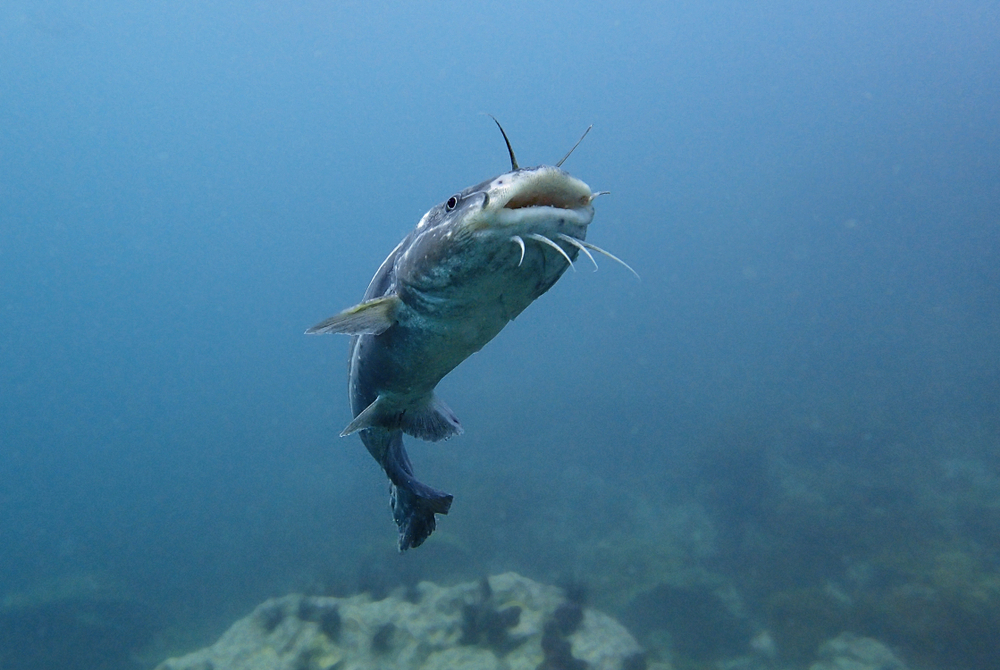
The blue catfish, which can exist found in Ohio, Missouri, Mississippi, and the Rio Grande River basins, was introduced to Virginia during the 1970s and 1980s.
Since then, they've been listed as an invasive species in the Chesapeake Bay tributaries.
Due to their rare ability to "sense of taste" what's effectually them (with the assistance of sensory tissues), they make avid hunters.
Their wide-ranging diet includes clams, worms, crustaceans, insects, smaller fish, and frogs, but their diet changes past the flavor. During the bound, summertime, and autumn, the blue catfish prefers feeding on aquatic vegetation.
When attacked by baldheaded eagles and osprey, blueish catfish utilise their serrated spinal barbs to defend themselves. The spines contain glands that release toxins, which can infiltrate wounds on the predators' bodies and cause a slap-up deal of pain.
To avoid being preyed on, young bluish catfish scour for food at night, rather than during the 24-hour interval, mainly eating zooplankton and tiny aquatic insects.
Males and females piece of work closely together when giving nativity to and raising their immature. It's the males that prepare the nest, and once that process is complete, they expel pheromones to attract and bring females to the nest.
Blue catfish reproduce speedily, creating 4,000 to eight,000 eggs for every kilogram of body weight. When the eggs are finished being fertilized, the males drive the females away and so they can be in charge of protecting the eggs.
Although both males and females play an active role in raising the young, it's the males who serve as the primary caretakers.
Blue catfish live for an average of 9–10 years, but some have lived as long as 25 years.
12. River Frogs
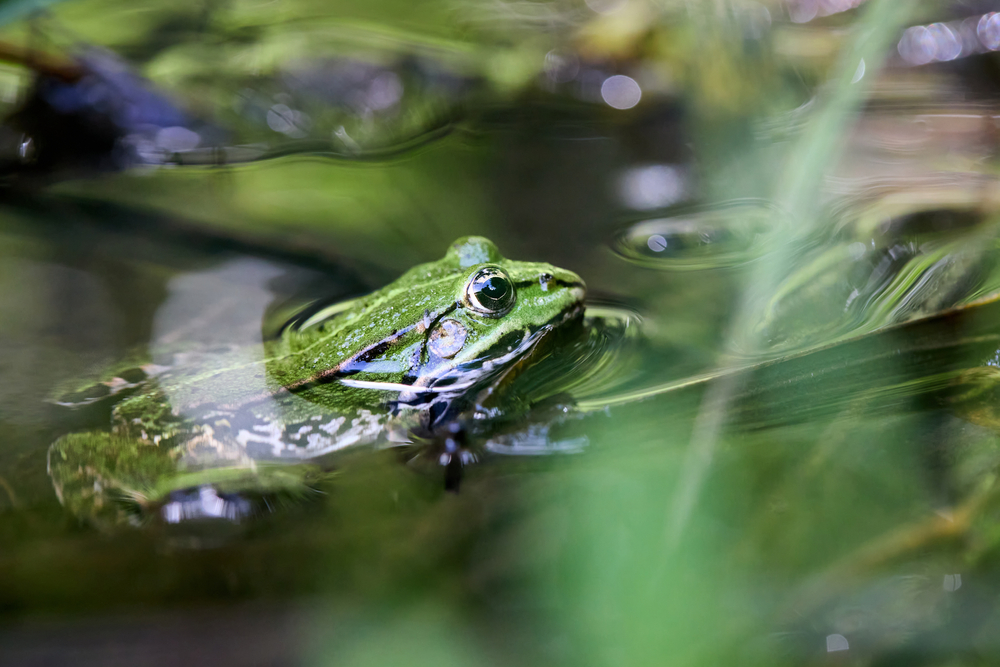
Although similar in appearance to their bullfrog cousins, river frogs are adequately piece of cake to distinguish by the light spots on their lips, peculiarly on the lower jaw.
Males can be distinguished by their throats, which are more than yellowish than females'. Females can be identified by their tympanum, which is either smaller than the eye or the aforementioned size.
Just similar their green frog relatives, river frogs don't have dorsolateral ridges, which are raised pare forth the sides of a frog's back.
Instead, river frogs have rougher and more than wrinkled pare across their bodies, making them relatively easy to place.
Tadpoles tin can exist identified by their large size (they tin attain a length of upwardly to v inches) and black margin on their fin.
Unlike most other frogs that have large tadpoles, river frog tadpoles showroom schooling behavior, which means they swim together.
Found throughout the Coastal Obviously of the southeastern portion of the US, river frogs inhabit a wide diverseness of habitats, including swamps, creeks, and rivers.
Rather than scurry abroad or hide from their predators, these nocturnal creatures play dead or release an unpleasant olfactory property when they sense danger.
Although river frogs are relatively common in Georgia'due south southern Littoral Evidently, they're believed to have become extinct in Due north Carolina.
Its population continues to decline in the Due east due to habitat loss from act.
Notwithstanding, as of now, there are no state or federal laws in place to protect this species.
13. Eurasian Beavers
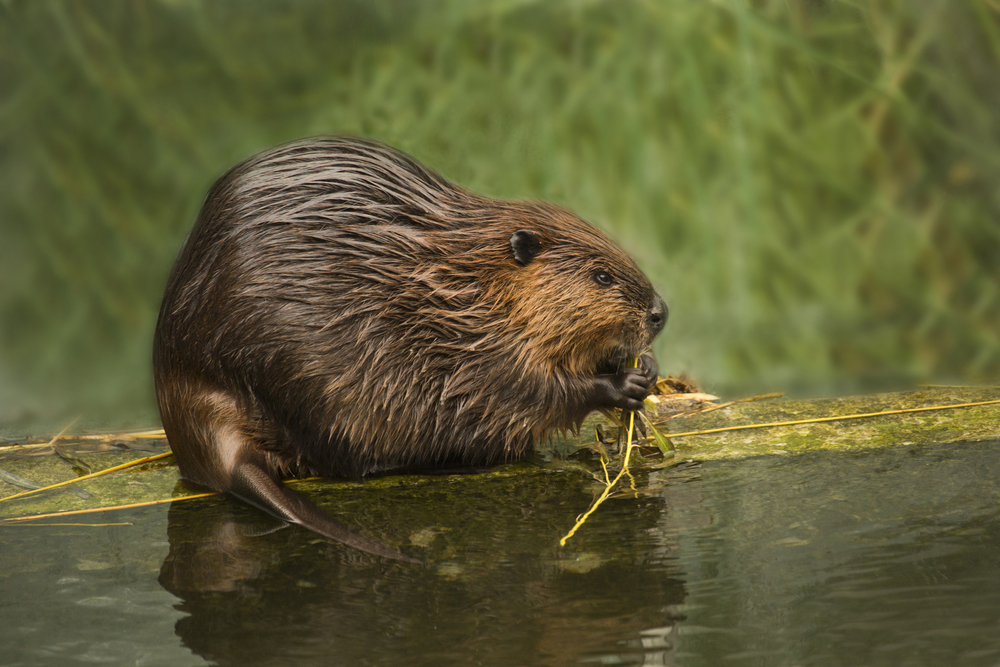
Once a widespread species in Nifty U.k. and throughout Europe, the Eurasian beaver, too known as the European beaver, saw a massive decline in population in several countries for many years.
By the 16th century, information technology was already extinct in Britain and, in 1900, its population consisted of only 1,200 beavers.
Still, the population has been partially restored thank you to laws and efforts to protect this species and the reintroduction of this species to European countries like Scotland, France, Deutschland, and Republic of austria.
In fact, the Scottish government formally recognized this creature every bit a native species in 2016.
Their distinctively broad, flat tail makes Eurasian beavers excellent swimmers and defined. They can dive for equally long as 5 to 6 minutes and can likewise couch into banks.
If there are no banks for them to employ, they build their own lodges using branches and soil.
They're also known (perchance most famously so) for building dams, developing floodplains that add together protection to their club and brand it easier for them to forage.
Their diet depends on the season. They feast on aquatic and herbaceous plants during the summer and consume bawl during the winter.
Eurasian beavers also store wood for the wintertime by felling young trees during the autumn months of October and Nov.
In the past, humans extensively hunted the beavers for their meat, fur, and castoreum. The beavers were also commonly attacked by wolves and lynx.
Now, their biggest threats are foxes and certain raptors, such equally the white-tailed hawkeye.
xiv. Diving Ducks
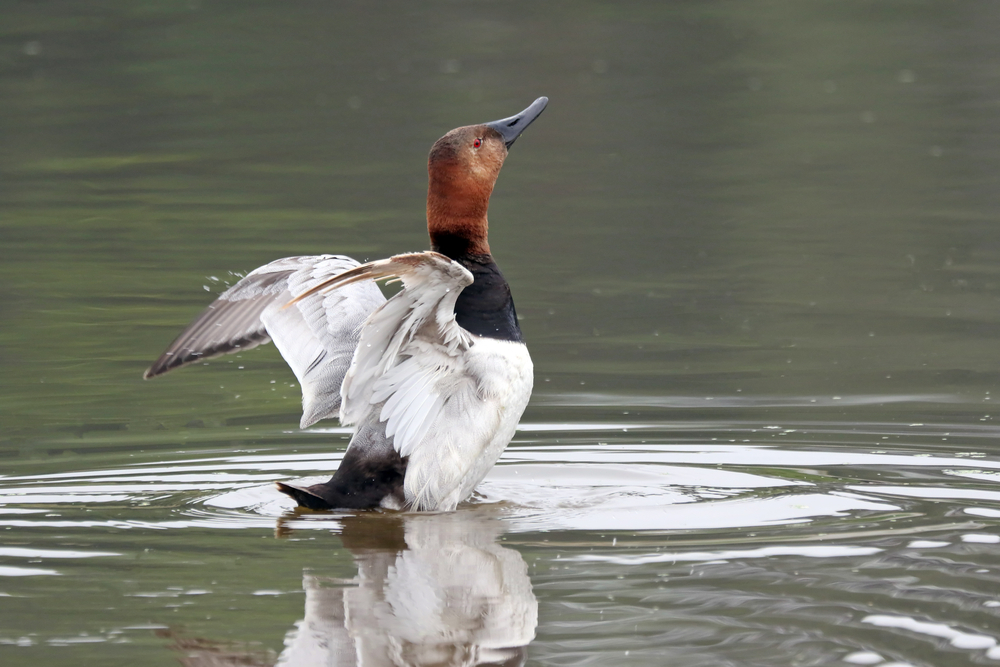
There are several diving duck species (e.thousand., canvasback, scaups, goldeneyes, and redheads), but they all have one special ability: they can dive well beneath the water'due south surface and chase and fodder for food, using their feet to movement underwater.
The unfortunate toll of their concrete makeup, however, is that they're awkward and ungainly on country. Therefore, these creatures spend well-nigh of their time in or on water.
Canvasbacks fly with rapid beats, making them, despite their heaviness, the fastest flyers among the diving duck family unit.
Their diet includes insects, fish, and aquatic plants.
While populations of certain duck species (such as canvasbacks and redheads) have oscillated throughout the years, scaups are in adequately high abundance.
This is, perhaps, due to the range of their breeding area, which includes one.two billion acres of boreal forest in Canada. Some other possible contributing gene is that their foods, such as insects, crustaceans, mollusks, and aquatic plants and seeds, are widely available.
15. River Dragonflies
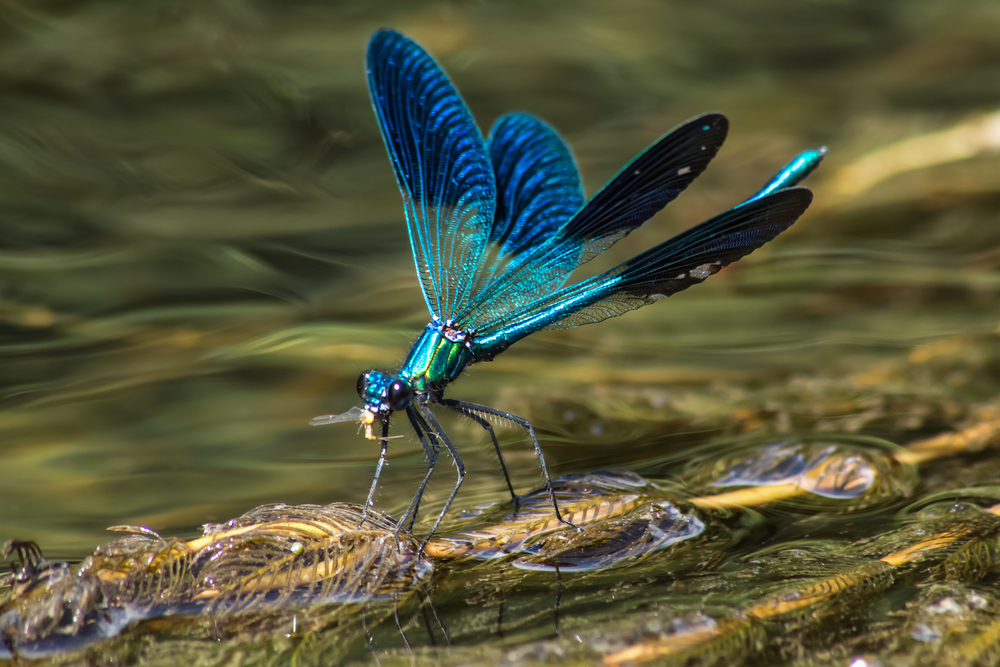
One would be hard-pressed to find a person who's never heard of this 4-winged insect known for its long, colorful body.
Dragonflies are usually sighted darting from ane identify to another or hovering over an area while they're searching for casualty.
Dragonflies are predatory, trapping other flying insects with their hairy legs. After capturing their prey, they feast using their powerful jaws, starting with the casualty's head.
Females lay their eggs by dropping them in the water or placing them in a plant near water. The larvae hatch out of their eggs about 10 days afterwards.
The larvae spend several years underwater – for some species, upwards to 8 years. During this phase, they consume tadpoles, aquatic insects, and even pocket-sized fish.
To escape from larger fish, their common predators, they forcefully squirt water from the ends of their abdomens, propelling them at a corking speed away from the danger.
When the larva is ready to transition into machismo, information technology stops eating and clutches firmly onto something. In a slow fashion, the developed dragonfly sheds itself of its outer peel. And then it unfurls its wings and, every bit the wings dry, the dragonfly rests.
Once the dragonfly feels rested and its wings are dry, it flies away in search of its first meal as an adult dragonfly.
Source: https://journeyz.co/types-of-animals-that-live-in-rivers/
Posted by: fergusonpainarompat1996.blogspot.com

0 Response to "What Kind Of Animals Live In Canals"
Post a Comment